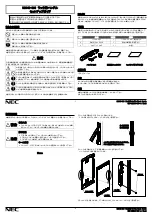
1. Installation
Your door is right handed if viewed from the
outside, the hinges are on the right
(See Fig.1)
All the locks are set in the factory for right hand opening
doors, to change to left hand opening refer to
Fig. 2 and
:
a) Remove the 2 BLUE screws and take off the plate.
b) Using the tweezers provided, take out the pin and insert
into the opposite hole.
c) Replace the plate and the screws.
2. Apply the template
• Tape the template to the door. Make sure that you fold it
along the appropriate line, depending on the backset of
the latch (60mm or 70mm).
• Mark and drill all six 10mm holes, holding a piece of
wood on the other side of the door with ‘G’ clamps to
prevent splintering.
• Use a chisel to clear the line of 4 x 10mm holes into a
single slot.
• To ensure trouble free operation holes must be drilled
accurately.
Positioning and fixing the latch
(See Fig.2a)
• Make a central point on the ‘Centre Line of the Latch’ on the
door edge.
• Drill a 25mm hole x 85mm deep.*
• Insert the latch into the hole and draw around the face plate.
• Remove the latch and cut a 3mm rebate so that the face plate will
fit flush with the door.
• Secure the latch with the wood screws.
*The cam in the latch must have space to rotate freely with sufficient clearance to move
upwards when the latch is being withdrawn.
3. Latch support post
Fit the latch support post in hole ‘A’ for a right handed door, or ‘B’ for a left
handed door. (See Fig. 3)
4. Right - Left handing pin
The locks are set at the factory as Right Handed, to change to Left Handed,
remove both blue screws and the retaining plate. Use tweezers to remove the
pin and put it in the opposite hole for Left Handed fitting.
Fig. 1
Fig. 2
Fig. 2a
5. Positioning the spindle
• Select the spindle to suit the thickness
of the door (Cut to length for DLK504).
• Insert the spindle through the slot in the
door and make sure that it engages the
latch correctly for the hand of the door.
(see Fig. 5)
6. Fixing the lock
• Cut the fixing bolts to suit the door thickness, allowing at least
one threaded section to screw into the lock case.
• Hold the lock case and the backplate, with the seals onto the
door with the spindle in position
• Using the fixing bolts, screw everything together through the top
and bottom holes of the backplate. Before final tightening ,
make sure the lock is vertical and test the mechanism to ensure
that it is all moving easily. (see Fig. 6). A
Allw
wa
ayyss cch
he
ecck
k tth
he
e
ffu
un
nccttiio
on
n iiff tth
he
e cco
od
de
e b
be
effo
orre
e ccllo
ossiin
ng
g tth
he
e d
do
oo
orr!!
7. Fitting the strike plate
• Position the strike plate on the door frame so that it lines up with
the flat of the latchbolt, NOT THE PLUNGER.
• Mark the inner & outer edges of the strike plate and cut a 1mm
rebate so that it fits flush with the surface of the door frame.
• Drill or cut a recess for the latchbolt.
• Fit the strike plate using only one wood screw at first to ensure
that it is positioned accurately. The latchbolt and NOT the the
plunger, should enter the aperture easily, and be held without
too much ‘play’.
• When satisfied, secure the strike plate with a second screw.
N.B. The plunger beside the latchbolt deadlocks the latchbolt and
protects it against manipulation. IT MUST NOT enter the strike plate
aperture when the door is closed.
8. Using the Lock
• In order to keep people from forgetting the password, you do not
need to input the password, just use the key to open it directly.
Or simply enter it in the box provided (below) and keep for future reference.
Fig. 3
Fig. 5
Fig. 6
Fig. 7 & 7a
C
New Code
MTL-949-5040K_Intructions.qxd 07/05/2009 07:40 Page 2




















